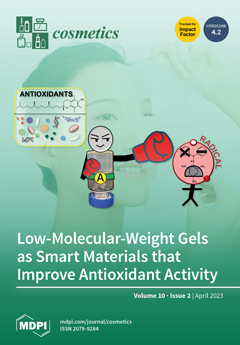Oenanthe javanica (OJ) is a perennial herb that grows wildly or is cultivated in Asia, and it is used as food or in traditional medicine. The antioxidant and anti-inflammatory effects of OJ-derived materials have been extensively explored previously, but their effects on the cytotoxicity of air pollution are currently unknown. Therefore, the present study aimed to evaluate the effect of the hot water extract of OJ on atmospheric particulate matter 10 (PM
10)-induced cytotoxicity and oxidative damage in human HaCaT keratinocytes, and to identify its active ingredient and mechanism of action. When the hot water extract of OJ was divided into methylene chloride, ethyl acetate (EA), n-butanol (BA), and water fractions, caffeic acid was enriched in the EA fraction and chlorogenic acid was enriched in the BA fraction. PM
10 increased reactive oxygen species (ROS) production, lipid peroxidation, protein carbonylation, and inflammatory prostaglandin (PG) E
2 production in cells. The BA fraction reduced the PM
10-induced ROS production in cells more effectively than the total extract and other solvent fractions. Chlorogenic acid was more effective in reducing ROS levels than caffeic acid and N-acetyl cysteine (NAC). Chlorogenic acid attenuated the increase in lipid peroxidation and the PG E
2 production of cells due to PM
10 exposure. Of the genes involved in PG E
2 production, phospholipase A2 group IVA (
PLA2G4A), Prostaglandin-endoperoxide synthase 1 (
PTGS1), and 2 (
PTGS2) were transcriptionally up-regulated by PM
10, whereas phospholipase A2 group IIA (
PLA2G2A) was down-regulated and prostaglandin E synthetase 1 (
PTGES1) and 2 (
PTGES2) were a little altered. The PM
10-induced increase in
PLA2G4A mRNA was alleviated by chlorogenic acid and NAC. Accordingly, PM
10 increased the expression levels of cytosolic phospholipase A2 (cPLA2) protein and its phosphorylated form, which were attenuated by chlorogenic acid and NAC. Thus, chlorogenic acid may attenuate the PM
10-induced PG E
2 production through the suppression of
PLA2G4A mRNA and cPLA2 protein expressions. This study suggests that chlorogenic acid contained in OJ extract may help alleviate the oxidative damage to and inflammatory responses of the skin cells due to exposure to air pollutants.
Full article





